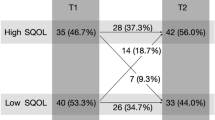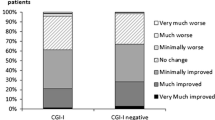Abstract
Purpose
The objective of this study was to analyze the clinical factors associated with changes in HRQoL in outpatients with schizophrenia using both generic and condition-specific HRQoL scales.
Methods
Adult outpatients with schizophrenia at least 18 years of age who did not have an acute psychotic exacerbation in the 3 months prior to baseline were recruited. PANSS dimensions were calculated based on Lindenmayer et al.’s five factors. HRQoL data were assessed by patients using the Schizophrenia Quality of Life Scale (SQLS), the Short Form-36 (SF-36), and the EuroQol-5 Dimension (EQ-5D) questionnaires.
Results
Out of the 1345 patients included at baseline, 1196 (89%) were evaluated at 12 months. Regression models showed that the factor most consistently associated with HRQoL at endpoint was change in the PANSS negative symptoms score. A decrease in the PANSS negative symptoms score from baseline to 1 year was associated with a decrease in HRQoL during the same period. There were also significant associations of the change in PANSS excitatory factor with all the HRQoL scales except the SF-36 PCS. Female gender was associated with a decrease in all HRQoL ratings. There was also a relationship between years since onset and HRQoL. The longer the time since illness onset, the larger the decrease in HRQoL.
Conclusions
This study has found that, in outpatients with schizophrenia, changes in negative and excitement symptoms may have a greater an association with HRQoL than changes in positive, cognitive and depressive symptoms.
Similar content being viewed by others
References
Cella DF (1995) Measuring quality of life in palliative care. Semin Oncol 22:73–81
Awad AG, Voruganti LNP (2012) Measuring quality of life in patients with schizophrenia: an update. Pharmacoeconomics 30:183–195. https://doi.org/10.2165/11594470
Boyer L, Baumstarck K, Boucekine M et al (2013) Measuring quality of life in patients with schizophrenia: an overview. Expert Rev Pharmacoecon Outcomes Res 13:343–349. https://doi.org/10.1586/erp.13.15
Rabin R, Charro F de (2001) EQ-SD: a measure of health status from the EuroQol Group. Ann Med 33:337–343. https://doi.org/10.3109/07853890109002087
Ware J, Sherbourne C (1992) The MOS 36-ltem Short-Form Health Survey (SF-36): I. Conceptual framework and item selection. Med Care 30:473–483
Brazier J, Connell J, Papaioannou D et al (2014) A systematic review, psychometric analysis and qualitative assessment of generic preference-based measures of health in mental health populations and the estimation of mapping functions from widely used specific measures. Health Technol Assess (Rockv) 18:1–188. https://doi.org/10.3310/hta18340
Papaioannou D, Brazier J, Parry G (2011) How valid and responsive are generic health status measures, such as EQ-5D and SF-36, in Schizophrenia? A systematic review. Value Heal 14:907–920. https://doi.org/10.1016/j.jval.2011.04.006
Haro JM, Altamura C, Corral R et al (2015) Understanding the impact of persistent symptoms in schizophrenia: cross-sectional findings from the pattern study. Schizophr Res 169:234–240. https://doi.org/10.1016/j.schres.2015.09.001
American Psychiatric Association (2000) Diagnostic and statistical manual of mental disorders. Diagnostic Stat Man Ment Disord 4th Ed TR. https://doi.org/10.1016/B978-1-4377-2242-0.00016-X
Lecrubier Y, Sheehan DV, Weiller E et al (1997) The Mini International Neuropsychiatric Interview (MINI). A short diagnostic structured interview: reliability and validity according to the CIDI. Eur Psychiatry 12:224–231. https://doi.org/10.1016/S0924-9338(97)83296-8
Kay SR, Fiszbein AOL (1987) The positive and negative syndrome scale for schizophrenia. Schizophr Bull 13:261–276. https://doi.org/10.1093/schbul/13.2.261
Lindenmayer JP, Grochowski S, Hyman RB (1995) Five factor model of schizophrenia: replication across samples. Schizophr Res 14:229–234. https://doi.org/10.1016/0920-9964(94)00041-6
Wilkinson G, Hesdon B, Wild D et al (2000) Self-report quality of life measure for people with schizophrenia: the SQLS. Br J Psychiatry 177:42–46. https://doi.org/10.1192/bjp.177.1.42
Jenkinson C, Coulter A, Wright L (1993) Short form 36 (SF 36) health survey questionnaire: normative data for adults of working age. BMJ 306:1437–1440
Dolan P, Gudex C, Kind P, Williams A (1995) A social tariff for EuroQol: results from a UK general population survey. Work. Paper
Jenkinson C, Wright L, Coulter a (1994) Criterion validity and reliability of the SF-36 in a population sample. Qual Life Res 3:7–12. https://doi.org/10.1007/BF00647843
Fransen M, Edmonds J (1999) Reliability and validity of the EuroQol in patients with osteoarthritis of the knee. Rheumatol 38:807–813. https://doi.org/10.1093/rheumatology/38.9.807
Linde L, Sørensen J, Ostergaard M et al (2008) Health-related quality of life: validity, reliability, and responsiveness of SF-36, 15D, EQ-5D [corrected] RAQoL, and HAQ in patients with rheumatoid arthritis. J Rheumatol 35:1528–1537 pii]
Ojeda N, Sánchez P, Peña J et al (2012) An explanatory model of quality of life in schizophrenia: the role of processing speed and negative symptoms. Actas Esp Psiquiatr 40:10–18
Galuppi A, Turola MC, Nanni MG et al (2010) Schizophrenia and quality of life: how important are symptoms and functioning? Int J Ment Health Syst 4:31. https://doi.org/10.1186/1752-4458-4-31
Bystritsky A, Liberman RP, Hwang S et al (2001) Social functioning and quality of life comparisons between obsessive-compulsive and schizophrenic disorders. Depress Anxiety 14:214–218. https://doi.org/10.1002/da.1069
Browne S, Roe M, Lane A et al (1996) Quality of Life in schizophrenia: relationship to sociodemographic factors, symptomatology and tardive dyskinesia. Acta Psychiatr Scand 94:118–124
Zeng Y, Zhou Y, Lin J et al (2015) Generic and disease-specific quality of life and its predictors among Chinese inpatients with schizophrenia. Psychiatry Res 228:724–728. https://doi.org/10.1016/j.psychres.2015.05.033
Katschnig H (2000) Schizophrenia and quality of life. Acta Psychiatr Scand Suppl 102:33–37. https://doi.org/10.1034/j.1600-0447.2000.00006.x
Cramer J, Rosenheck R, Xu W et al (2000) Quality of life in Schizophrenia: a comparison of instruments. Schizophr Bull 26:659–666. https://doi.org/10.1093/oxfordjournals.schbul.a033484
Rofail D, Regnault A, le Scouiller S et al (2016) Health-related quality of life in patients with prominent negative symptoms: results from a multicenter randomized Phase II trial on bitopertin. Qual Life Res 25:201–211. https://doi.org/10.1007/s11136-015-1057-9
Guajardo VD, Terroni L, Sobreiro MDFM. et al (2015) The influence of depressive symptoms on quality of life after stroke: a prospective study. J Stroke Cerebrovasc Dis 24:201–209. https://doi.org/10.1016/j.jstrokecerebrovasdis.2014.08.020
Schram MT, Baan CA, Pouwer F (2009) Depression and quality of life in patients with diabetes: a systematic review from the European depression in diabetes (EDID) research consortium. Curr Diabetes Rev 5:112–119. https://doi.org/10.2174/157339909788166828
Mulhern B, Mukuria C, Barkham M et al (2014) Using generic preference-based measures in mental health: psychometric validity of the EQ-5D and SF-6D. Br J Psychiatry 205:236–243. https://doi.org/10.1192/bjp.bp.112.122283
Rouillon F, Eriksson L, Burba B et al (2013) Functional recovery results from the risperidone long-acting injectable versus quetiapine relapse prevention trial (ConstaTRE). Acta Neuropsychiatr 25:297–306. https://doi.org/10.1017/neu.2013.7
Payakachat N, Ali MM, Tilford JM (2015) Can the EQ-5D detect meaningful change? A systematic review. Pharmacoeconomics 33:1137–1154. https://doi.org/10.1007/s40273-015-0295-6
Sonntag M, König H-H, Konnopka A (2015) The responsiveness of the EQ-5D and time trade-off scores in schizophrenia, affective disorders, and alcohol addiction. Health Qual Life Outcomes 13:114. https://doi.org/10.1186/s12955-015-0315-4
McCrone P, Patel A, Knapp M et al (2009) A comparison of SF-6D and EQ-5D utility scores in a study of patients with schizophrenia. J Ment Health Policy Econ 12:27–31
Awad AG, Voruganti LN, Heslegrave RJ (1997) Measuring quality of life in patients with schizophrenia. Pharmacoeconomics 11:32–47. https://doi.org/10.2165/11594470-000000000-00000
Hsiao C-Y, Hsieh M-H, Tseng C-J et al (2012) Quality of life of individuals with schizophrenia living in the community: relationship to socio-demographic, clinical and psychosocial characteristics. J Clin Nurs 21:2367–2376. https://doi.org/10.1111/j.1365-2702.2012.04067.x
Xiang Y-T, Weng Y-Z, Leung C-M et al (2010) Gender differences in sociodemographic and clinical characteristic and the quality of life of Chinese schizophrenia patients. Aust N Z J Psychiatry 44:450–455. https://doi.org/10.3109/00048670903489858
Narvaez JM, Twamley EW, McKibbin CL et al (2008) Subjective and objective quality of life in schizophrenia. Schizophr Res 98:201–208. https://doi.org/10.1016/j.schres.2007.09.001
Dimitriou P, Anthony D, Dyson S (2009) Quality of life for patients with schizophrenia living in the community in Greece. J Psychiatr Ment Health Nurs 16:546–552. https://doi.org/10.1111/j.1365-2850.2009.01413.x
Hermes Ed, Sokoloff D, Stroup S, T., & Rosenheck RA (2012) Minimum clinically important difference in the positive and negative syndrome scale with data from the clinical antipsychotic trials of intervention effectiveness (CATIE). J Clin Psychiatry 73:526–532. https://doi.org/10.4088/JCP.11m07162.Minimum
Coretti S, Ruggeri M, McNamee P (2014) The minimum clinically important difference for EQ-5D index: a critical review. Expert Rev Pharmacoecon Outcomes Res 14:221–233. https://doi.org/10.1586/14737167.2014.894462
Cohen J (1988) Statistical power analysis for the behavioral sciences. Stat Power Anal Behav Sci 2:567. https://doi.org/10.1234/12345678
Bobes J, A-Portilla PG (2005) Quality of life measures in schizophrenia. Eur 20 (Suppl 3):S313–S317. https://doi.org/10.1016/S0924-9338(05)80182-8
Gandek B, Ware JE, Aaronson NK et al (1998) Cross-validation of item selection and scoring for the SF-12 health survey in nine countries: results from the IQOLA project. J Clin Epidemiol 51:1171–1178. https://doi.org/10.1016/S0895-4356(98)00109-7
Ware JE, Gandek B, Kosinski M et al (1998) The equivalence of SF-36 summary health scores estimated using standard and country-specific algorithms in 10 countries: results from the IQOLA Project. J Clin Epidemiol 51:1167–1170. https://doi.org/10.1016/S0895-4356(98)00108-5
Ciconelli RM, Ferraz MB, Santos W et al (1999) Tradução para a língua portuguesa e validação do questionário genérico de avaliação de qualidade de vida SF-36 (Brasil SF-36). Rev Bras Reumatol 39:143–150
Augustovski FA, Lewin G, Elorrio EG, Rubinstein A (2008) The Argentine-Spanish SF-36 Health Survey was successfully validated for local outcome research. J Clin Epidemiol. https://doi.org/10.1016/j.jclinepi.2008.05.004
Devlin NJ, Brooks R (2017) EQ-5D and the EuroQol group: past, present and future. Appl Health Econ Health Policy 15:127–137. https://doi.org/10.1007/s40258-017-0310-5
Jenkinson C (1999) Comparison of UK and US methods for weighting and scoring the SF-36 summary measures. J Public Health Med 21:372–376. https://doi.org/10.1093/pubmed/21.4.372
Janssen MF, Pickard AS, Golicki D et al (2013) Measurement properties of the EQ-5D-5L compared to the EQ-5D-3L across eight patient groups: a multi-country study. Qual Life Res 22:1717–1727. https://doi.org/10.1007/s11136-012-0322-4
Cordoba R, Cano JF, Arango-Davila CA et al (2012) Study of flexible doses of paliperidone ER in patients with schizophrenia who have undergone inefficient treatment with other antipsychotics. Rev Colomb Psiquiatr 41:340–356. https://doi.org/10.1016/S0034-7450(14)60009-3
Stefanovics EA, Elkis H, Zhening L et al (2014) A cross-national factor analytic comparison of three models of PANSS symptoms in schizophrenia. Psychiatry Res 219:283–289. https://doi.org/10.1016/j.psychres.2014.04.041
Ruggeri M, Nosè M, Bonetto C et al (2005) Changes and predictors of change in objective and subjective quality of life: multiwave follow-up study in community psychiatric practice. Br J Psychiatry 187:121–130. https://doi.org/10.1192/bjp.187.2.121
Funding
The Pattern Study was funded by F. Hoffmann-La Roche Ltd, Basel, Switzerland, who freely provided the database to the authors. The statistical analyses and the manuscript were produced independently of Roche.
Author information
Authors and Affiliations
Corresponding author
Ethics declarations
Conflict of interest
Cristina Domenech has no conflict of interest. Carlo Altamura has served as a consultant or advisory board member for F. Hoffmann-La Roche, Ltd., Lundbeck, Merck, Astra Zeneca, Bristol Myers Squibb, Janssen-Cilag, Sanofi, Eli Lilly, Pfizer and Otsuka. Corrado Bernasconi is a contractor of F. Hoffmann-La Roche, Ltd. Helio Elkis has received research grants from the São Paulo Research Foundation (FAPESP), Janssen-Cilag and Roche, participated on advisory boards for Janssen-Cilag and Roche, and received honoraria and travel support from Janssen-Cilag and Roche. Ashok Malla has received honoraria or participated in advisory boards or educational conferences or received research funding for investigator-initiated projects from Janssen Canada, Pfizer Canada, Bristol-Myers-Squib, F. Hoffmann- La Roche, Ltd., Otsuka, Lundbeck and Astra-Zeneca. Anna-Lena Nordstroem is an employee of F. Hoffmann-La Roche, Ltd. Mathias Zink has received unrestricted scientific grants from the European Research Advisory Board, German Research Foundation, Servier, Pfizer Pharma GmbH, Bristol-Myers Squibb GmbH & CoKGaA, and speaker and travel support from Pfizer Pharma GmbH, Bristol-Myers Squibb, Otsuka, Astra Zeneca, Eli-Lilly, Janssen Cilag, Servier, Trommsdorff and F. Hoffmann-La Roche Ltd. Marie-Odile Krebs has received honoraria from and participated in advisory boards for F. Hoffmann-La Roche, Ltd. Josep Maria Haro has acted as a consultant, participated in advisory boards or given educational presentations for Eli Lilly and Co., Lundbeck, Otsuka, F. Hoffmann-La Roche Ltd. and Takeda. Jonathan Evans and Ricardo Corral have no conflicts of interest.
Informed consent
The protocol and consent procedures were approved by all local institute review boards/ethics committees before study initiation. All patients and caregivers provided informed consent.
Rights and permissions
About this article
Cite this article
Domenech, C., Altamura, C., Bernasconi, C. et al. Health-related quality of life in outpatients with schizophrenia: factors that determine changes over time. Soc Psychiatry Psychiatr Epidemiol 53, 239–248 (2018). https://doi.org/10.1007/s00127-018-1483-4
Received:
Accepted:
Published:
Issue Date:
DOI: https://doi.org/10.1007/s00127-018-1483-4




